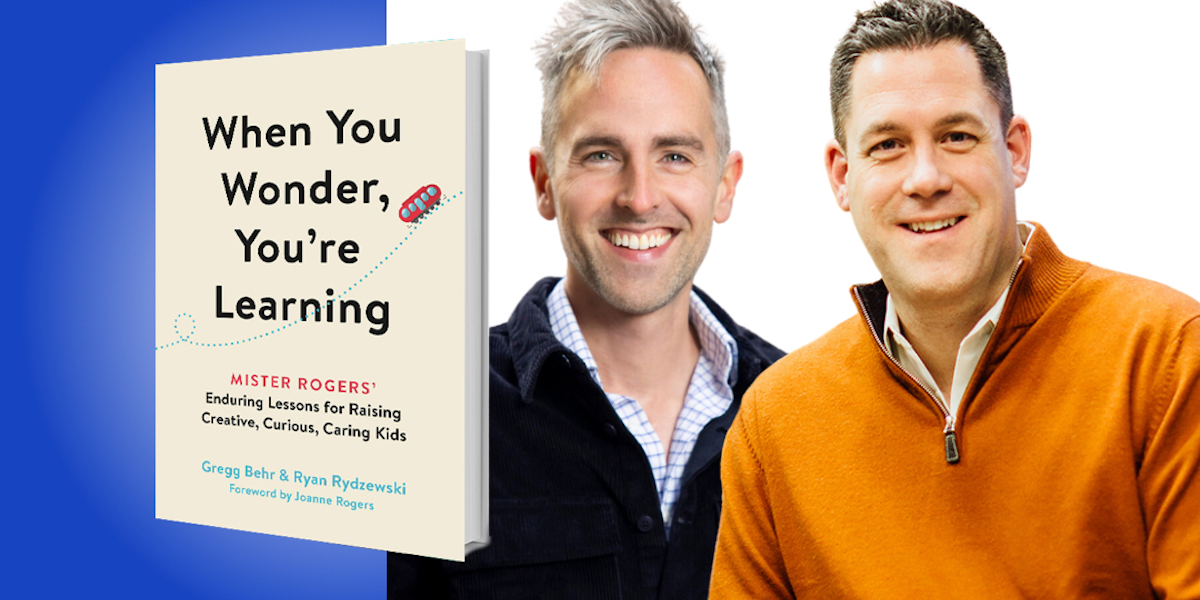Ryan Rydzewski is a science and education reporter. Gregg Behr is executive director of The Grable Foundation and founder of Remake Learning. Their new book uncovers the science behind Mister Rogers’ Neighborhood, exploring how kids—and their parents—can excel at what Rogers taught best: being human.
Below, Ryan shares 5 key insights from When You Wonder, You’re Learning: Mister Rogers’ Enduring Lessons for Raising Creative, Curious, Caring Kids (available now from Amazon). Listen to the audio version—read by Ryan himself—in the Next Big Idea App.
1. When it comes to children’s learning, the presence of caring adults outweighs almost everything else.
In 1969, when Fred Rogers was trying to save the Corporation for Public Broadcasting from being defunded, he testified to the Senate that above all, he felt that his job on television was to “give an expression of care every day to each child.”
That sounds obvious, right? Of course kids need caring adults around them—but decades after Mister Rogers’ Neighborhood debuted, science is only now starting to catch up with it. We’re starting to learn in a very real, quantifiable way just how right Rogers was, and just how effective his philosophies and methods really are.
Let’s take one out of countless examples of this. In the 1980s, researchers at the University of Washington launched a long-term study of about 800 kids, which they divided into groups. The researchers gave the parents and teachers of one group a series of lessons and tools designed to help adults build stronger relationships with children. The parents and teachers of the rest were the control group, meaning they didn’t receive any extra help at all.
Thirty years later, in 2019, the researchers compared the two groups and, just as Mister Rogers might have predicted, the kids whose parents and teachers had been taught to build stronger relationships outperformed their peers on everything. They were happier, they made more money, they were healthier physically, and they were more likely to be involved in their communities. This held true across race, gender, and class.
“The kids whose parents and teachers had been taught to build stronger relationships outperformed their peers on everything.”
The researchers summed up their findings with a surprisingly simple statement. The most important thing they learned was the value of just being present: “Make sure your kids have the opportunity to engage with you as a parent. Play with them, hold them, don’t just sit on your phone when you’re with them . . . And you’re likely to be setting them up to have better lives long into the future.”
2. Great learning requires a sense of safety that’s both physical and psychological.
It’s a fact of human biology that we just don’t think very well when we feel like we’re in danger. When we’re faced with a threat, whether it’s one of physical harm or rejection from a group of our peers, our stress-response systems take over. The resources that normally power our cognition—things like curiosity, complex thinking, and even compassion—are routed instead to our bodies, getting us ready to fight, flee, or freeze.
So, if we want our children to learn, it’s up to adults to help minimize the threats that trigger those stress responses. Now, that doesn’t mean lying to kids, or avoiding conflict, or ignoring the distressing realities of the world—kids have to learn to handle that stuff, and with our help, they absolutely can. But it does mean that it’s our job to help kids feel safe.
If you were to watch the first episode of Mister Rogers’ Neighborhood, which aired in 1968, and then watch the last episode, which aired in 2001, you wouldn’t notice a lot of differences. Yes, one is black-and-white and the other is color, and yes, Rogers himself has aged 30-some years, but the set, the songs, and the structure are all largely the same. Almost every episode starts with Rogers talking to us in his living room. Then, we go off to the Neighborhood of Make-Believe for a while, before coming back to Mister Rogers to talk about what we’ve seen.
Considering the changes that took place outside of that TV studio over the course of three decades, it’s remarkable how consistent Rogers kept things for the camera. And that was deliberate—he knew that consistent routines and structures helped kids feel safe. By maintaining this trustworthy TV world, he was helping kids feel relaxed enough to be able to learn. Even his trademark hellos—the changing of his shoes, the zipping of his sweaters—conveyed a sense of welcoming and warmth. And so, Rogers created a world that didn’t ignore outside threats, but that made kids feel safe from them, if only for 28 minutes.
“There’s so much science now showing that this feeling of psychological safety is absolutely essential to learning and to how kids—and adults, too—function in relation to one another.”
And then, of course, there were his songs, all of which he wrote to help kids feel that they are enough, that they are worthy of acceptance right now, exactly as they are, regardless of what they know or don’t know; regardless of what they look like; regardless of their individual strengths and faults. There’s so much science now showing that this feeling of psychological safety is absolutely essential to learning and to how kids—and adults, too—function in relation to one another.
Google did a study of its own teams a few years ago. The company’s statisticians found that teams that lacked psychological safety—where people were made to feel inadequate or unworthy—missed their sales goals by an average of 19 percent. And the teams that felt psychological safety exceeded their goals by almost the same amount, because members were so readily able to learn, both as individuals and as a unit.
3. Environment shapes behavior.
This is another truth of learning that Rogers seemed to get on a fundamental level, and which he deployed in some really ingenious ways. If you think about learning spaces today, you’ll find amazing technology, at least one caring adult, and the things we typically associate with learning: books, desks, a chalkboard or a smartboard, and so on. But in the United States, we haven’t always given a lot of thought to—or placed a lot of value on—physical spaces: what the lighting does, how the furniture feels, what materials things are made of. Mister Rogers knew that that stuff matters, and the learning sciences are once again proving him right.
One of the tools for learning is creativity, and we know so much more now about how our physical surroundings can support or detract from our creative output. In a 2002 study, researchers gauged the creativity of high school students in different settings, including the sort of sterile, plastic-and-drywall rooms that characterize traditional classrooms. What they found was that students were far more creative in spaces with lots of materials, like wood and sunlight, places where things look natural and well-crafted—places that look, in other words, a lot like Rogers’ living room.
“Environments like this one erase fear. They cure cancer of the human spirit. And the kids inside them blossom.”
Today, places that prioritize physical environments are seeing amazing results. One example is the Manchester Craftsmen’s Guild, a community arts center based in Pittsburgh that operates campuses around the world. They serve kids from some of Pittsburgh’s lowest-income neighborhoods, recruiting world-class educators to teach photography, ceramics, digital arts—and all of this happens in this incredible building. The Guild’s founder, Bill Strickland, is an artist himself, and he hired a student of Frank Lloyd Wright to design the center.
There’s glass and wood and sunlight everywhere. There’s art on every wall. There are orchids. When we visited, Bill said something we’ll never forget: “Everywhere you look here, there’s something beautiful looking back. That is deliberate. Environments like this one erase fear. They cure cancer of the human spirit. And the kids inside them blossom.” And he’s right: 98 percent of the Guild’s kids graduate from high school on time. 85 percent go on to some kind of secondary education. They’ve never had an incident of violence, and they’ve never called the police. There’s been no need—environment shapes behavior.
4. Adults’ values don’t always match up with the things that kids think we value.
If there’s one thing that set Fred Rogers apart from your average caring adult, it was the intentionality and thoughtfulness with which he communicated with kids. Talking to young people is something that feels intuitive to a lot of adults, but as the psychologist Haim Ginott once wrote, “conversing with kids is a unique art, one with rules and meanings of its own.” Rogers understood this in ways that can be really helpful to parents and teachers today.
We’ll give you an example of one of the gulfs between what adults say and what kids actually hear. When adults are asked about their highest hopes for their children, the vast majority agree that the most important thing is that kids grow up to be caring adults who prioritize family, generosity, and community. On surveys, at least, our values are clear: We think that caring about others is way more important than what grades or awards kids get.
“Effective communication with kids—or really, with anyone—does one particular thing: It acknowledges and respects the other person’s feelings, even if we don’t agree with those feelings.”
What kids hear, though, is a completely different story. According to Harvard’s Graduate School of Education, about 80 percent of young people say that their parents and teachers are more concerned about grades and achievement than anything else. Even adults’ unconscious cues can filter down to kids. One of the remarkable things about Mister Rogers’ Neighborhood is that no one walked away from it wondering how Fred Rogers saw them. In every episode, his message to kids was clear: I see your potential and your worth, exactly as you are. You are loved and capable of loving, and if you can come to see that in yourself and in the people around you, then you’ll have what you need to succeed, regardless of what success might look like for you.
So, what can we learn from the man in the cardigan sweater? It all comes down to how we listen and how we talk. Effective communication with kids—or really, with anyone—does one particular thing: It acknowledges and respects the other person’s feelings, even if we don’t agree with those feelings. Now, that’s easier said than done; kids, like all human beings, can be downright baffling. But when we make space to listen to kids without judging them, and without projecting our assumptions, our experiences, or even our well-intentioned words of wisdom, we start to do what Rogers did, which is see children as people whose feelings and hopes and fears are every bit as deep and real as our own.
When we talk to people from this place of understanding, they become more receptive to hearing us, and vice versa. We can have real conversations that close those unintended gulfs. The Buddhist monk Thich Nhat Hanh calls this deep listening and loving speech, which is a phrase that’s also a just-about-perfect description of the Neighborhood.
5. Unstructured time is not necessarily wasted time.
When you watch Mister Rogers as an adult, one of the first things you’ll notice is the sheer amount of silence he deploys. There’s a stillness to the Neighborhood that you generally don’t find in other TV programs. In fact, while TV and movies today include a cut, on average, every 2 to 3 seconds, Rogers allowed no more than two cuts per minute. The program moves much more slowly, and there’s a lot of unfilled space.
Like everything else Rogers did, this was by design. His program embraced a fact that we’ve come to ignore in this always-on, hyperconnected world we’ve built, which is this: For all of our emphasis on speed and instantaneous access, our best ideas and our purest inspiration come in moments of quiet. We do our best thinking and learning not when we’re barraged by fast-moving media or by the internet’s buzzing hive mind, but when we’re disconnected, unplugged, and alone. And even—or perhaps especially—when we’re bored.
“Kids need that downtime in order to feel wonder, and to develop interests that are authentic to them, rather than those imposed by adults.”
In recent years, there’s been an explosion of interest in this idea among scientists, writers, and workplace experts who are trying to help people focus during a time of constant distraction. But when it comes to kids and learning, there’s a sort of cultural pressure to fill every moment with something productive. And so, it’s no wonder that unstructured free time is disappearing from families’ schedules.
The perceived risks of sitting still are huge, and even when we do relax, we have this unlimited menu of things to watch and posts to read and songs to listen to, thanks to the devices in our pockets. Try to remember the last time you just sat still, with no screens, no media, no cognitive input from someone else’s brain. For most of us, it’s probably been a while.
The irony is that this relentless focus on productivity is, in many ways, counterproductive. Rogers knew this, and that’s why you see scenes in the Neighborhood like an egg timer counting down a full minute, or Rogers turning a houseplant ever so slightly, again and again, so that kids can see it from every possible angle. There’s even an episode that finds Rogers literally watching paint dry. The point of all this was twofold. The first was to give kids space to think and to process. And the second was just to trust them. Rogers knew that when we let them, kids can and will fill periods of downtime with their own curiosity and creativity. Rogers knew that kids need that downtime in order to feel wonder, and to develop interests that are authentic to them, rather than those imposed by adults.
The benefits are enormous. When we trust kids to use their imaginations, to wonder about the questions that interest them, and to come up with their own ways to play, we’re giving them space to become creative, industrious, self-motivated individuals. We’re giving them space to figure out who they are, to figure out what delights them, what bothers them, what moves them.
This doesn’t mean that we, the adults, don’t get involved. Just the opposite: Psychologists have found that it helps when adults encourage and even join in children’s play, and when they provide simple objects like building blocks. This is so important that in 2018, the American Academy of Pediatrics released a “prescription” for the nation’s parents: Go play with your kids, every single day.
We’ve known it for a long time, but those pediatricians made it official: The lessons we learned in Mister Rogers’ Neighborhood are just what the doctor ordered.
To listen to the audio version read by Ryan Rydzewski, download the Next Big Idea App today:































